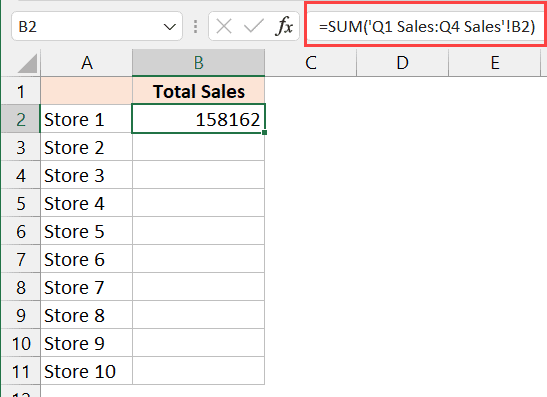5 Ways to Sum Across Multiple Sheets in Excel

Excel has long been the go-to tool for businesses, analysts, and hobbyists who need to organize and analyze data. A common challenge many users face is managing data spread across multiple sheets. In this comprehensive guide, we delve into five effective methods to sum across multiple sheets in Excel, each offering unique advantages to streamline your data summarization processes.
Method 1: Using 3D References

3D references provide a way to reference the same cell or range of cells across multiple worksheets in Excel. This method is perfect when you want to sum a consistent range or cell across sheets.
- Navigate to the summary sheet: This is where your final sum will be calculated.
- Select the cell: Choose the cell where you want to display the total sum.
- Enter the formula: Type in
=SUM(Sheet1:Sheet3!A1)if you want to sum cell A1 from Sheet1 through Sheet3.
💡 Note: Ensure all sheets are consistently formatted, as 3D references can lead to errors if sheets lack the referenced cell.
Method 2: Consolidate Function

Excel’s Consolidate function allows for summing data from multiple sheets into a summary sheet. Here’s how:
- Prepare your data: Make sure each sheet has the same structure and contains the data you need to sum.
- Go to the summary sheet: Click on the cell where you want the consolidated data.
- Launch the Consolidate tool: From the Data tab, select Data Tools > Consolidate.
- Select your function: Choose “Sum” from the Function dropdown.
- Reference ranges: Click “Browse” to add each sheet’s range to the “Reference” list, then click Add.
- Check options: If needed, tick “Create links to source data”.
- Finish: Click OK to sum the data.
Method 3: Using SUMIF and SUMIFS

The SUMIF and SUMIFS functions are powerful when you need to sum conditionally. Here’s how to use them for summing across multiple sheets:
| Function | Description |
|---|---|
| SUMIF | Sums based on a single condition. |
| SUMIFS | Sums based on multiple conditions. |

- Set up your sheets: Ensure the data you want to sum is in a consistent range across sheets.
- On the summary sheet: Type in the formula like
=SUMIF(Sheet1:Sheet3!A1:A10, “>=100”, Sheet1:Sheet3!B1:B10)for SUMIF or=SUMIFS(Sheet1:Sheet3!B1:B10, Sheet1:Sheet3!A1:A10, “>=100”)for SUMIFS.
💡 Note: Conditions and ranges must be uniform across all sheets for accurate results.
Method 4: VBA Macro

VBA (Visual Basic for Applications) can be used to automate the process of summing across sheets, offering a flexible solution for complex scenarios:
- Open the VBA editor: Press Alt + F11 to open.
- Insert a new module: Right-click on any workbook’s project and Insert > Module.
- Write your macro: Below is a simple macro to sum cell A1 from all sheets:
- Run the macro: Press F5 or go to Developer > Macros > Run.
Sub SumAcrossSheets()
Dim ws As Worksheet
Dim total As Double
For Each ws In ThisWorkbook.Worksheets
total = total + ws.Range(“A1”).Value
Next ws
Range(“B1”).Value = total
End Sub
Method 5: Power Query

Power Query, introduced in Excel 2010, is an advanced tool that simplifies data transformation and aggregation:
- Enable Power Query: In newer versions, Power Query is on the Data tab. For older versions, it needs to be installed.
- Import data: Select the sheets you want to sum by going to Data > From Other Sources > From Microsoft Query.
- Combine data: In Power Query, append or merge data as necessary.
- Aggregate and load: Sum the required column and load the result into your summary sheet.
Summing data across multiple sheets in Excel doesn't have to be an overwhelming task. Each of the methods outlined in this post provides a pathway to simplifying your data analysis, each with its own merits. Whether you opt for the straightforwardness of 3D references, the flexibility of VBA, or the robustness of Power Query, Excel offers tools for every level of Excel proficiency. By embracing these techniques, you'll unlock new levels of efficiency in your spreadsheet management, ensuring your data-driven decisions are based on consolidated and reliable information.
Can I sum different cells across different sheets with 3D references?

+
No, 3D references are limited to summing the same cell or range across sheets. You’ll need a different approach if cells vary.
Are macros required for summing across multiple sheets?

+
No, while macros offer automation, other methods like 3D references or Power Query can be used effectively without VBA.
How do I ensure my sum across sheets updates automatically?

+
Formulas using 3D references or functions like SUMIF/SUMIFS automatically update if you’re using a linked Excel file or dynamic ranges. For VBA, you’ll need to manually run or automate the macro.



